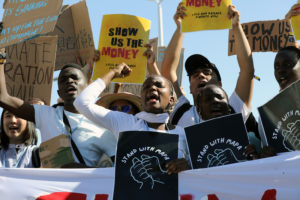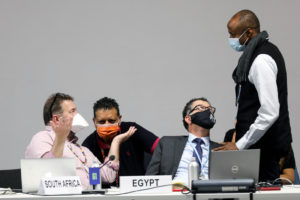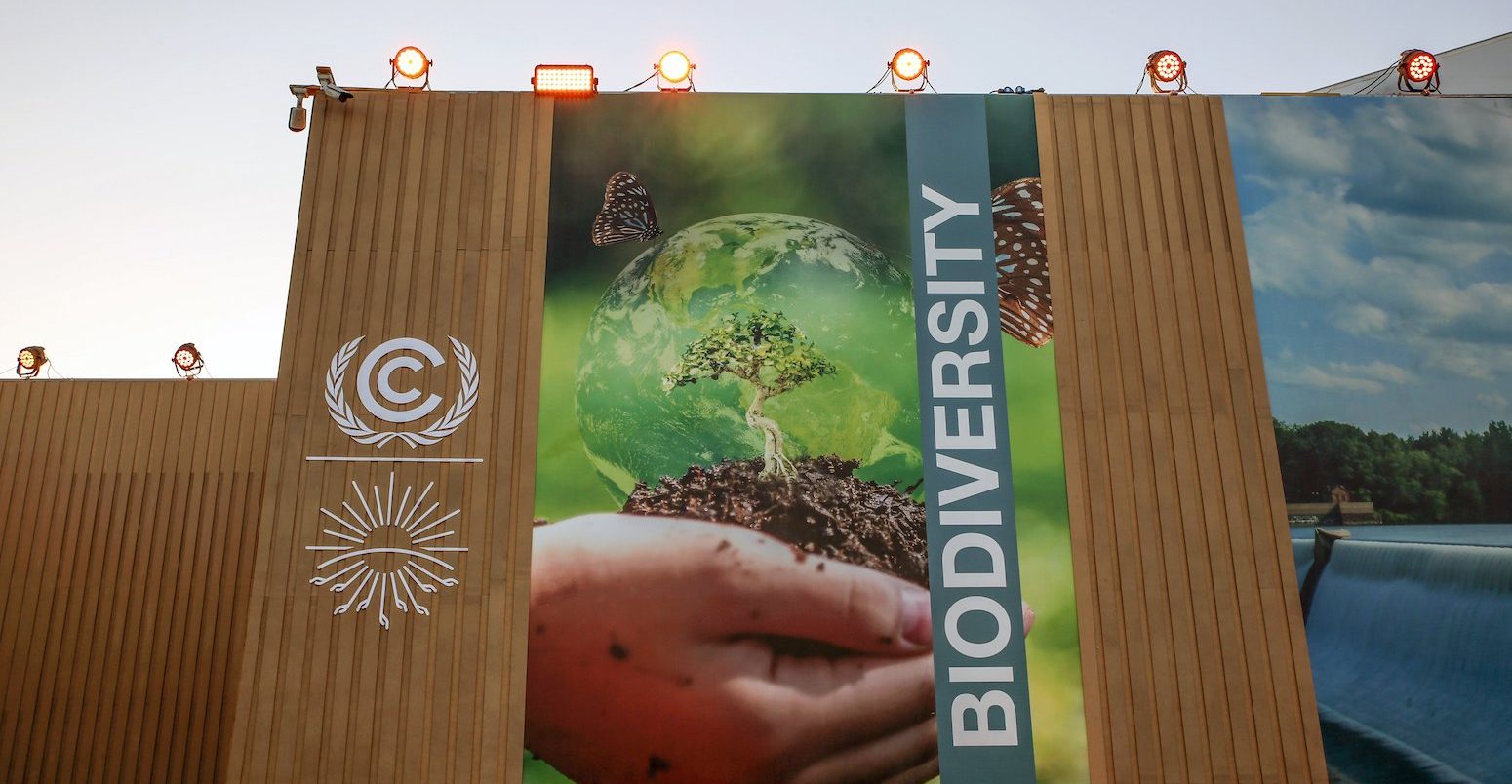
COP27: Key outcomes for food, forests, land and nature at the UN climate talks in Egypt
Multiple Authors
11.24.22Multiple Authors
24.11.2022 | 2:24pmThe COP27 summit in the Egyptian coastal resort of Sharm el-Sheikh made history by including food, rivers, nature-based solutions, tipping points and the right to a healthy environment in an overarching COP “cover decision” for the first time.
The town, best known for its Red Sea reefs, saw more than 33,000 delegates descend on its shores for the COP27 summit, the first in Africa since Morocco hosted COP22 in 2016.
This year’s summit was set against a backdrop of record-high levels of hunger and multi-year droughts that continue to grip many parts of the continent.
Agriculture and food security – thought to have been at risk of dropping off the climate talks’ agenda – were given a stronger mandate and a four-year lease of life through the “Koronivia work programme”. Sharm el-Sheikh also hosted the first food-systems pavilion at a COP.
Elsewhere at COP27, hundreds of delegates queued to catch a glimpse of incoming Brazilian president Luiz Inácio Lula da Silva (known as “Lula”), who promised “zero deforestation” by 2030.
Lula’s arrival was preceded by a pact signed on the sidelines of the concurrent G20 meeting in Indonesia, where Brazil, Indonesia and the Democratic Republic of the Congo (DRC) announced an alliance that campaigners dubbed the “Opec for rainforests”.
During a side-event at COP27, Colombia and Venezuela proposed relaunching the 1978 Amazon Cooperation Treaty Organisation, a pact between Brazil, Bolivia, Guyana, Peru, Suriname and Venezuela to protect the Amazon rainforest.
Beyond the first-ever food pavilion and decision-text references, however, COP27 saw less money on the table for restoration of forests than the previous year, fears over how carbon removals would be included in opaque new carbon markets and the presence of “big agriculture” lobbyists trying to influence negotiations.
Here, Carbon Brief provides in-depth analysis of all the key outcomes in Sharm el-Sheikh – both inside and outside the COP.
- Food and nature in the cover decision
- Koronivia Joint Work for Agriculture
- Deforestation pledges
- Road to COP15
- New COP27 initiatives
- Carbon markets and Article 6
Food and nature in the cover decision
For the first time in history, the overarching COP “cover decision” mentioned food, rivers, nature-based solutions and the right to a healthy environment – recently recognised as a human right by the UN General Assembly and the UN Human Rights Council.
Another first!…
— Leo Hickman (@LeoHickman) November 20, 2022
The mention of “food” in a cover decision.
In fact, even though in the preamble, the wording is pretty strong and nuanced pic.twitter.com/uwQaymVDGK
The final decision text, which emerged just after 4am on Sunday morning as the talks ran deep into overtime, recognises “the fundamental priority of safeguarding food security and ending hunger” and the vulnerability of food production to climate change.
It also “acknowledges that climate change exacerbates the global food crises and vice versa, particularly in developing countries”.
Using shorthand for the fallout of Russia’s war in Ukraine on food and fertilisers, but not explicitly mentioning it, the text “stresses” that the “global geopolitical situation and its impact on energy, food and economic situations” should not be used as an excuse for “backsliding or deprioritising climate action” – as has been seen in recent months.
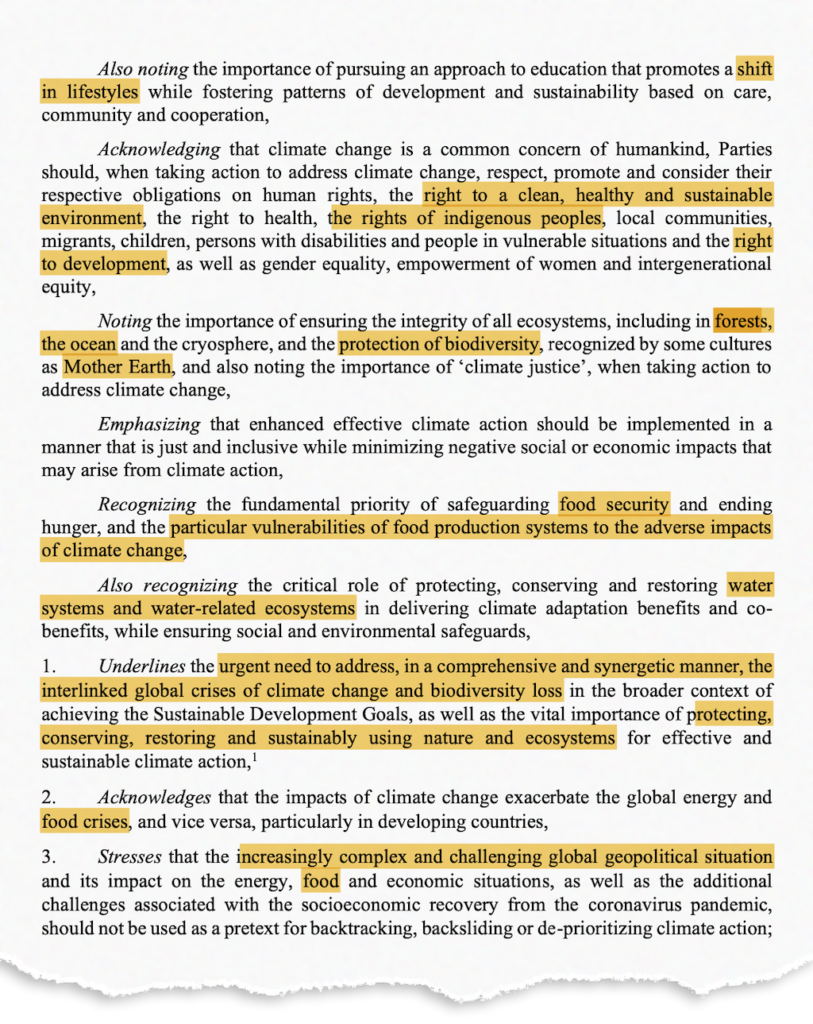
Cover decisions have been assuming more importance at recent COPs – a trend that not all countries favour, but that many consider extremely important. (See Carbon Brief’s key outcomes from COP27 piece for more context on the importance of cover decisions.)
According to Paul Watkinson, a former chair of the Subsidiary Body for Scientific and Technological Advice who is now working with the United Arab Emirates’ COP28 presidency, the pattern began with COP25 in Madrid. Watkinson told Carbon Brief last year that using the text as a “political overview decision” gives subjects, words or points a place “that may or may not exist elsewhere”.
Given the jargon and complexity inherent in most negotiation texts, it is understandable that media and the general public tend to focus on the cover decision. Additionally, there is pressure for these overarching cover decisions to reflect or signal global political realities, as well as accommodate country, bloc or presidency preferences that are often not echoed in negotiations.
For instance, a nod to a “whole of food systems perspective” was deleted from the preamble of a decision text on agriculture (see Koronivia), as some countries were concerned about that phrase’s implications for consumption, production, mitigation, food security and farmers.
However, the preamble of the cover text, known as the Sharm el-Sheikh Implementation Plan, notes “the importance of transition to sustainable lifestyles and sustainable patterns of consumption and production for efforts to address climate change”.

In another first, forests got their own entire section in the cover text. The section reflects language in the Paris Agreement on reducing emissions from deforestation and forest degradation (REDD+), but also alludes to “joint mitigation and adaptation approaches”, which could be a possible reference to Article 6.2 carbon markets, from which REDD+ activities are currently excluded.
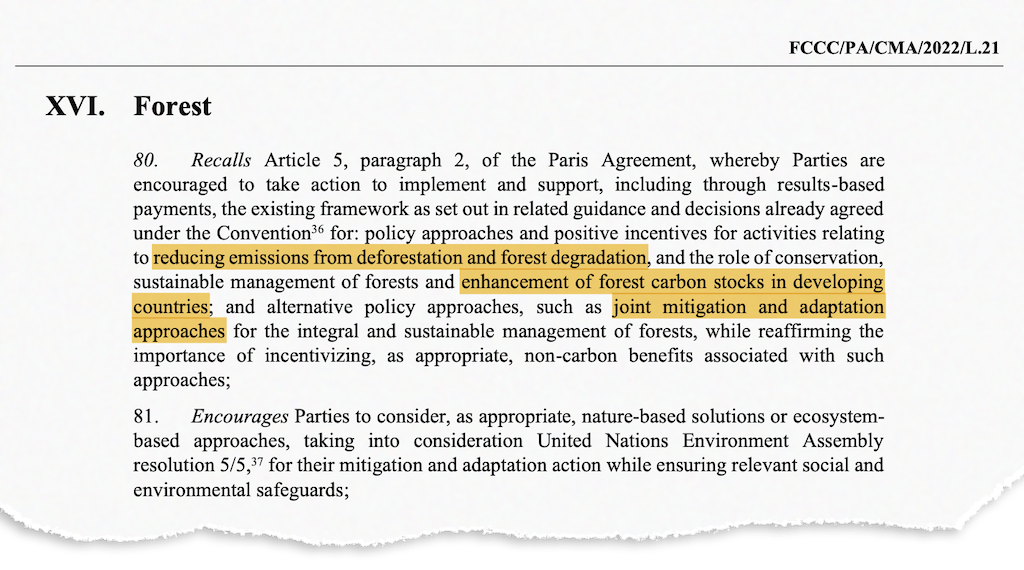
Another departure from Glasgow’s language is a line that refers to the controversial concept of “nature-based solutions” (NBS). These were a major priority for the UK government at COP26, but not for everyone – as shown by the back-and-forth on their inclusion in what became the Glasgow Climate Pact.
In the Glasgow pact, references to NBS were eventually replaced with “protecting, conserving and restoring nature and ecosystems”.
The Sharm el-Sheikh plan does not explicitly mention the COP15 UN biodiversity summit, which is taking place in Montreal in less than a fortnight from now. But the text “underlines the urgent need to address, in a comprehensive and synergetic manner, the interlinked global crises of climate change and biodiversity loss”.
Water – an oft-overlooked element of food security and biodiversity despite floods and droughts dominating 2022 headlines – also finds a mention. Dr Aditi Mukherji of the Consultative Group on International Agricultural Research (CGIAR) and lead author on the chapter on water in the Intergovernmental Panel on Climate Change (IPCC) sixth assessment report on the impacts of climate change, told Carbon Brief that this is a historic first:
“The cover recognises the critical role of protecting, conserving and restoring water systems and water-related ecosystems in delivering climate adaptation benefits and co- benefits, while ensuring social and environmental safeguards. The draft mentions water for the first time. None of the previous COP texts had any mention of water, even though it has been increasingly established that the majority of climate-exposed populations experience climate change through water impacts.”
While nature, food, land, biodiversity and water all get explicit mentions in the COP27 cover text, how they find a home elsewhere in the negotiations tells another story.
Koronivia Joint Work for Agriculture
With food prices rising globally, but especially in wheat-importing countries such as Egypt, which relies on Russia and Ukraine for grain, commentators have been warning of a “new Arab spring”.
In a year that saw war impacting supply chains of key commodities, heatwaves, drought and floods affecting key crops and record levels of hunger, agriculture and food security were expected to be a key priority for the Egyptian presidency and countries at COP27.
The Koronivia Joint Work for Agriculture, the only formal UNFCCC workstream for food, was renewed for another four years at COP27, as parties agreed to continue working on “implementation of climate action on agriculture and food security”.
The UN has a range of bodies dedicated to different aspects of food, covering food aid (World Food Programme) to trade (World Trade Organisation) through to an intergovernmental platform on food security and nutrition (Committee on World Food Security). But Koronivia was the only dedicated forum under the UNFCCC to bring together discussions about agriculture and climate change.
Koronivia was set up via a landmark decision in 2017, at COP23 in Bonn, as a subject under both subsidiary bodies of the UN climate regime. It set out to address six interrelated topics: soils; nutrient use; water; livestock; adaptation and its co-benefits; and the socio-economic and food security dimensions of climate change across agriculture.
After a series of cross-cutting workshops on these subjects that nearly all participants said they found useful, Koronivia was scheduled to wrap up at COP26 in Glasgow.
At COP26, however, countries could not come to an agreement on what they had conclusively, collectively learned from these workshops. They also could not reach consensus on what the “roadmap” for the future of Koronivia should look like.
They did agree, though, that they would come to a decision at COP27 on whether work on food would continue – and, if yes, in what form.
In their submissions ahead of COP27, parties were divided about whether Koronivia should go on, for how long, governed by whom and in what format – namely, as a constituted body under the UNFCCC, as a work programme or just linked to other UN bodies. To many observers, the format did not matter as much as an assurance that the work would continue.
Where should Koronivia go, if it goes on?
— Aruna Chandrasekhar (@aruna_sekhar) November 12, 2022
Will it be a mechanism, a work programme, a constituted body? Each has its own power, ability to call meetings, ⌛️ and 💸 implications.
Countries have different perspectives on that, too. pic.twitter.com/etSVGaKeBj
Tensions over mitigation and loss and damage made headlines towards the end of COP27. But, at the end of week one, the subsidiary body chairs said that agriculture “took more meeting time than any other item at COP27”.
Campaigners feared that, given the prospect of Koronivia being pushed by another year, agriculture was “limping on and possibly heading towards an abyss”, according to Bernadette Fischler Hooper, head of international advocacy at WWF UK.
A negotiating draft for discussion on Koronivia’s future emerged late on 11 November, with only a day to go before the subsidiary bodies had to conclude their work.
While this text agreed to set up “joint work”, just how long it would run was not agreed upon. It also mentioned a possibility to broaden the scope of the work to take a “whole of food-system perspective”, which became a key dividing element between countries that already have language around food systems in policies, such as the EU’s Farm to Fork Strategy, versus countries who were either unclear or reluctant to talk about aspects such as consumption and diets.
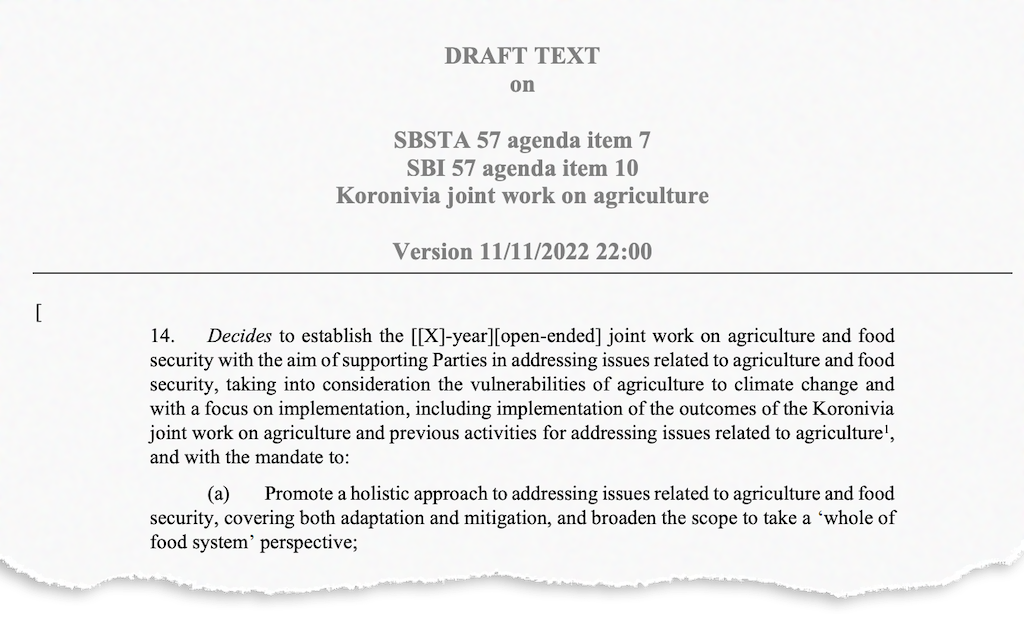
The “G77 plus China” negotiating bloc reportedly wanted references to broadening the scope to a “whole of food systems” approach deleted, while countries such as the UK, France and Switzerland wanted to keep food systems in. According to a report in Devex, the G77 was opposed to the “food systems” language because it “needed more clarification”.
Eventually, the subsidiary bodies forwarded both texts in brackets – one on conclusions and the other on Koronivia’s future – to be picked up by the COP, with the Egyptian presidency agreeing to work on the text and work with parties to find common ground.
❌The data❌
— Jazmín Rocco Predassi (@JazPredassi) November 11, 2022
Koronivia Joint Work on Agriculture has had more than 20 hours of negotiations in the past week, more than any other agenda item. Yet… Negotiations will continue next week under #COP27
At the start of the second week of COP27, 29 organisations, including WWF, the Environmental Defense Fund, Food and Land Use Coalition and GAIN, appealed to negotiators in an open letter, asking them to retain “sustainable food systems” language “in the context of the Koronivia Joint Work on Agriculture, which means taking a particular focus on sustainable food production, nutrition and dietary shifts, as well as food loss and waste”.
Mid-way through the second week, a new combined text emerged, with the mention of a “whole of food systems” approach deleted, a tentative three-year timeline in brackets and more language on implementation, support and vulnerability included.
With both docs combined, 🥁🥁 new🌾draft text: L (old), R (new). https://t.co/hk6yxtBU5A
— Aruna Chandrasekhar (@aruna_sekhar) November 15, 2022
Possibly a 3-yr joint work programme?
Missing: ‘whole of food system’ perspective.
Added/emphasised: implementation, support, adaptation priorities of vulnerable groups, nat circumstances pic.twitter.com/6vUtOo1fUN
On Thursday, Koronivia consultations concluded just shy of midnight, producing a mostly agreed text, including a definite four-year timeline for agriculture and food security and a new proposed Sharm el-Sheikh online portal for countries to share information.
However, with India objecting to the words “climate action” and preferring “action”, both options appeared in brackets in that draft’s title.
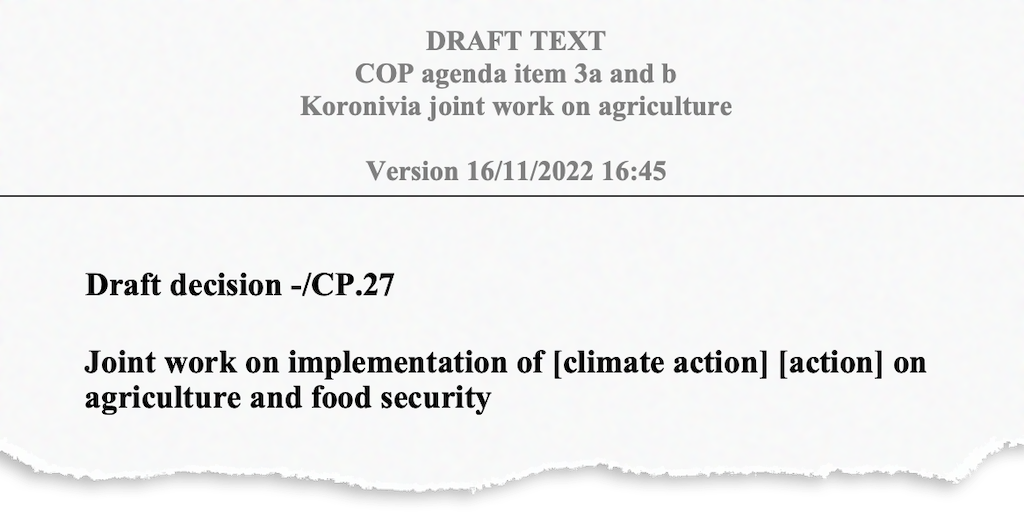
While title brackets were removed the next day, references to a first workshop on food systems were deleted on the insistence of the US, observers told Carbon Brief.
1/8. My quick take on #agrifood systems related outcomes from @COP27P
— Dr. Aditi Mukherji (@aditimukherji) November 20, 2022
1. The term food systems has been meticulously avoided in #Koronovia because of sensitivities around demand side measures such as diets by developed countries, and mitigation concerns by developing countries
Clean text notwithstanding, India pushed back on the Koronivia draft decision on Friday, the day COP was scheduled to close. India alleged, as reported by the Hindu, that “developed countries are blocking a pro-poor and pro-farmer decision by insisting on expanding the scope for mitigation to agriculture, thereby compromising the very foundation of food security in the world”. To date, India has not made a submission on Koronivia’s future or recommendations.
Eventually, an agreed text on Koronivia was passed at the COP on Sunday morning, shortly before the final gavel. It was the only agenda item that drew interventions from countries in the closing plenary, with Turkey asking for language around water insecurity to be amended and Russia objecting to any such changes.
Despite the fight and deletions, the final text on Koronivia “points us in the right direction for agriculture”, said Teresa Anderson, the global lead on climate justice at ActionAid. She told Carbon Brief:
“It was actually one of the more inclusive, if not the most inclusive processes in the UNFCCC. Often the keynote speaker at the workshops was a woman smallholder farmer from Malawi or Zimbabwe and it was quite a different tone from the rest of the negotiations and you start to see it in the reports. What filtered through ended up pointing us in the right direction. If we’d seen agroecology in the text, we’d be celebrating, but there are clear signals that we might not be galloping but we’re tiptoeing in the right direction.
“It didn’t give big agriculture the space it was hoping for, but really emphasised the input of smallholder farms, the importance of food security and equity. All of that came through.”
Many welcomed the decision, but still wanted to see more language and actions across the whole food system. Mamadou Goita, director of the Institute for Research and Promotion of Alternatives in Development (IRPAD), told Carbon Brief:
“The industrial food system is responsible for over a third of global warming emissions – and now finally the UN climate talks are recognising that. It’s a significant step to see that the UN climate agreement will begin to target greater action to tackle the enormous emissions from industrial agriculture and provide funding to make agriculture more resilient to climate change. But if actions are not incorporated across the whole food system, from food waste and loss to sustainable supply chains and healthy diets, we will fail to meet the world’s great food and climate challenges.”
New COP27 initiatives
Every day, delegates lining up outside the COP27 venue were witness to vegan protestors dressed in pig and cow costumes, despite the blazing sun.
Their demands varied from calls for a “Plant-Based Treaty”, which championed cell-based meat through to highlighting what they viewed as meat and dairy greenwashing at COP27.
Meanwhile, for the first time ever, COP27 hosted pavilions dedicated solely to food and agriculture. It was an attempt to turn the spotlight on the relationship between climate change and food systems, in the middle of a global food crisis.
These vegan activists have been the only visible protesters at COP27 this week (they’re here every day) pic.twitter.com/jiEdELjDZ0
— Emma Gatten (@emmagatten) November 11, 2022
The conference’s blue zone housed three different stages for food: a Food and Agriculture pavilion set up by the FAO, CGIAR and the Rockefeller Foundation; a food systems pavilion; and a Food4Climate pavilion hosted by ProVeg International, the only stall at the COP27 to serve coffee with oat milk.
The Egyptian presidency and the FAO jointly launched the Food and Agriculture for Sustainable Transformation Initiative (FAST), which aims to improve the “quantity and quality of climate finance contributions” towards food systems by 2030 and to “support adaptation and maintain a 1.5C pathway whilst supporting food and economic security”.
Speaking at a side event held at COP27, FAO deputy director-general Maria Helena Semedo, pointed out that while climate finance has increased over the past decade, the share going to agriculture has been steadily decreasing.
The FAO also told Reuters that it was planning to launch a roadmap within the year that would show how the food industry and farming could align with the world’s 1.5C warming goals. The Rome-based food organisation hopes that this plan would mirror the International Energy Agency’s (IEA) influential annual reports for the energy sector that have “spurred investment” into 1.5 C-aligned projects and technologies, according to the story.
In June, over 40 investors managing $14 trillion urged for such a plan to make agriculture sustainable, pointing to the fact that none of the 16 NDCs submitted by G20 leaders had disclosed targets for reducing agricultural emissions. Investor network Farm Animal Investment Risk & Return (FAIRR) Initiative expects that such a plan could provide guidance on methane emissions and what a just transition for farmers could look like.
Separately, the US, EU, Norway, Germany and the Netherlands announced an additional $135m of funding for fertiliser and soil-health programmes in sub-Saharan Africa and in “key middle-income countries”.
The funding is part of US president Joe Biden’s Global Fertilizer Challenge that was launched to “address the global fertiliser shortages” sparked, “in part, by the war in Ukraine”.
Another closely watched initiative was the US and COP28 host United Arab Emirates’ Agricultural Innovation Mission for Climate, which is also referred to as AIM4C or AIM4Climate.
AIM4C says that it hopes to boost investment “and other support” for “climate-smart agriculture and food-systems innovation over five years (2021-25)” to the tune of $8bn. On 12 November – Agriculture Day at COP27 – AIM4C held a high-profile ministerial hosted by the Egyptian presidency, with an invitation to the private sector to raise resources.
However, DeSmog pointed out in an investigation that AIM4C was “bias[ed] towards industry-friendly climate initiatives such as precision farming, carbon farming and lowering the methane in cow burps”.
The outlet highlighted that US agriculture secretary Tom Vilsack is “a former chief executive of a major dairy-industry lobbying firm” and that he had launched initiatives such as “dairy net-zero” at COP27.
Lim Li Ching, panel expert with IPES-Food and senior researcher at Third World Network, responding to the flurry of agricultural announcements at COP27, said in a statement:
“Despite all the green buzzwords, COP27 has seen a number of initiatives simply doling out more support to big agribusinesses and their large-scale extractive model of industrial agriculture that’s causing climate change. Small-scale farmers have done little to cause the climate crisis but their needs and solutions are being crowded out.”
ActionAid’s Teresa Anderson said that both US initiatives are emissions-heavy, technology-focussed and chemical-fertiliser-friendly. They intend, she said, to give delegates the impression that “the real heroes feeding the world are tech bros in suits and lab coats generously scattering their brilliance onto the needy farmers of the world.” She told Carbon Brief:
“Launching these programmes during climate negotiations feels like all that they need to do to get a climate veneer, a very thin one. They’re trying to climate-wash their climate-harming initiatives by launching them during COP. Aim for climate, but fail miserably.”
COP27 also saw an update to the Global Methane Pledge, a multi-country initiative to slash methane emissions by 30% by 2030, first launched at COP26 and spearheaded by the US and the EU.
Speaking during a ministerial meeting alongside EU climate chief Frans Timmermans and COP27 president Sameh Shoukry, US special climate envoy John Kerry announced that 150 countries had now sign up to the pledge. (At its launch at COP26, the US estimated that 80-100 countries were signed up.)
Kerry added that, as well as tackling methane emissions from oil and gas production, committed countries would also begin to tackle methane from waste and animal agriculture, including through efforts to change the “diets of cattle”. (Scientists are clear that people living in the global north will need to cut back meat consumption if the world is to meet its climate goals.)
New signatories since COP26 include Australia, Egypt and Qatar.
China, the world’s largest annual methane emitter, is not signed up to the pledge. However, China’s special climate envoy Xie Zhenhua made a surprise appearance at the session and told the audience that his country had drafted its own national methane strategy.
In a statement, Kim O’Dowd, campaigner at the Environmental Investigation Agency, a UK-based non-governmental organisation, said:
“What the world desperately needs now are real actions and commitments – something far more meaningful to address the ongoing crisis. We cannot wait for another climate summit to deliver on the promises made with the Global Methane Pledge.
“Negotiations for a global methane agreement have to start now, with concrete and binding objectives, mandatory reporting, monitoring and verification, national actions plans and targeted financial support to ensure implementation.”
Elsewhere at the conference, a report released by the Institute for Agriculture and Trade Policy and the Changing Markets Foundation found that the combined methane emissions of 15 of the world’s largest meat and dairy companies are higher than those of several of the world’s biggest methane emitters, including Russia, Canada and Australia.
Deforestation pledges
COP27 saw the arrival of several new multi-country initiatives for tackling deforestation and restoring carbon-rich ecosystems.
It comes after tropical deforestation remained “stubbornly high” in 2021, according to the World Resources Institute’s Global Forest Watch. Tropical regions lost 11m hectares of tree cover in 2021, including nearly 4m hectares of pristine forests, Global Forest Watch said.
In the summit’s first week, the UK announced the arrival of the forests and climate leaders’ partnership, a group of 26 countries – representing a third of the world’s forests – that will meet twice yearly to “track commitments” on efforts to “halt and reverse forest loss by 2030”.
The initiative is designed to build on the Glasgow Leaders’ Declaration on Forests and Land Use declaration made last year at COP26. However, as Climate Home News noted in its reporting, that declaration had had the backing of 145 nations representing over 90% of the world’s forests – suggesting most nations declined to up their deforestation commitments by signing up to the new initiative.
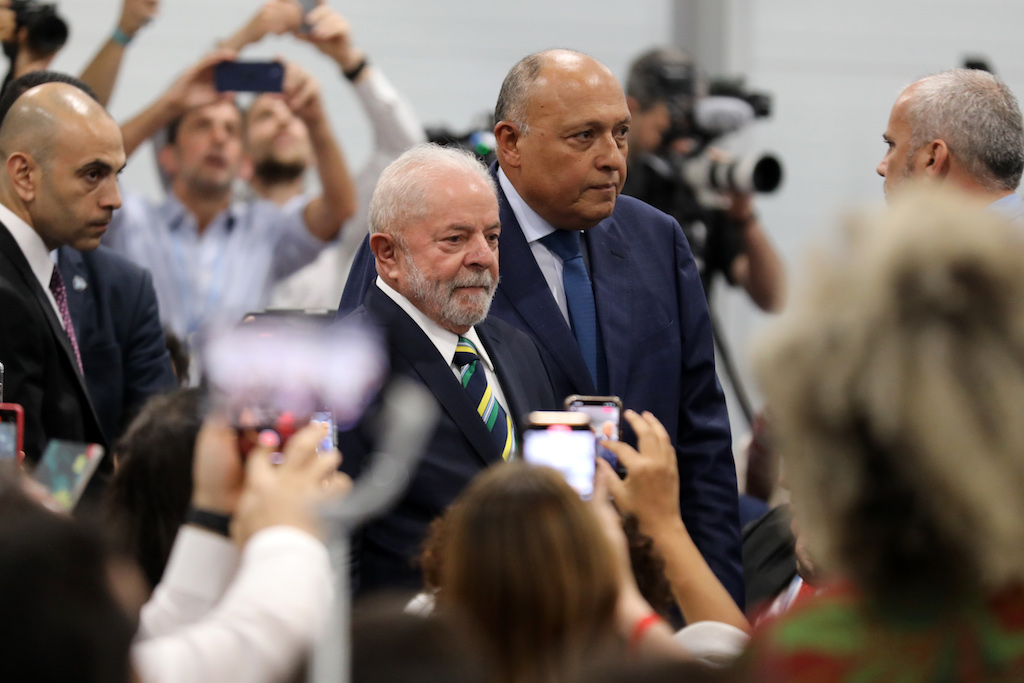
Those that declined to join the UK’s new initiative include the DRC, Brazil, Russia, China and Peru. These countries together account for nearly half of the world’s forests.
UK prime minister Rishi Sunak held a special event at COP27 to announce the initiative alongside Dutch prime minister Mark Rutte, Egyptian prime minister Dr Mostafa Madbouly and Senegalese president Macky Sall.
However, Sunak caused momentary global panic when he appeared to spontaneously dash out from the room during the announcement – as captured by Carbon Brief’s editor Leo Hickman.
UK prime minister @RishiSunak has just been rushed out of the room by his aides during the middle of the launch for forests partnership at #COP27 pic.twitter.com/OQy9TYkqpX
— Leo Hickman (@LeoHickman) November 7, 2022
(A spokesperson for 10 Downing Street later claimed Sunak left after a “late decision” to meet with representatives from Germany and South Africa.)
Elsewhere, France also announced a new initiative to protect areas high in “carbon and biodiversity”, such as “ancient forests, peat bogs or mangroves”.
Backed by the US and China, France said it would like to work with countries to form “positive conservation partnerships” with rainforest nations. Costa Rica, Colombia, Gabon and the Philippines affirmed their interest in being partners, France added.
Another headline-grabbing initiative was a new pact between Brazil, Indonesia and the DRC, dubbed the “Opec of rainforests” by campaigners. The three nations are home to half of the world’s tropical forests.
Widely trailed at COP27, but signed in Indonesia ahead of the G20 meeting of nations, the new pact agrees that the three countries should be paid to tackle deforestation and boost carbon stores in their forests, Reuters reported.
It also says that the countries will work to negotiate “a new sustainable funding mechanism” to help developing nations preserve their biodiversity and to increase funding through the UN’s REDD+ programme for cutting deforestation.
Prior to signing, DRC environment minister Eve Bazaiba told reporters:
“South-to-south cooperation – Brazil, Indonesia, DRC – is very natural. We have the same challenges, the same opportunity to be the solution to climate change.”
During his speech to COP27, Lula promised that the new alliance would be “strengthened under my government”.
Lula🇧🇷:
— Daisy Dunne (@daisydunnesci) November 16, 2022
🌴Recommits Brazil to reaching “zero deforestation”
🌴Will create a “ministry of Indigenous and native peoples” to ensure “dignity, peace, sustainability” for land defenders
🌴Germany & Norway “reigniting” Amazon fund after his victory pic.twitter.com/1l3044zbdy
Speaking to Carbon Brief at the sidelines of COP27, Prof Simon Lewis, a leading forest scientist at University College London and the University of Leeds, said that the new alliance had the potential to make a “very powerful” impact on deforestation rates. He explained:
“If you look at deforestation indicators for Indonesia and Brazil, it’s like a see-saw: when one falls, international demand just shifts to the other region.”
A strategic alliance could, in theory, help the rainforest nations to better manage and control this demand, he added.
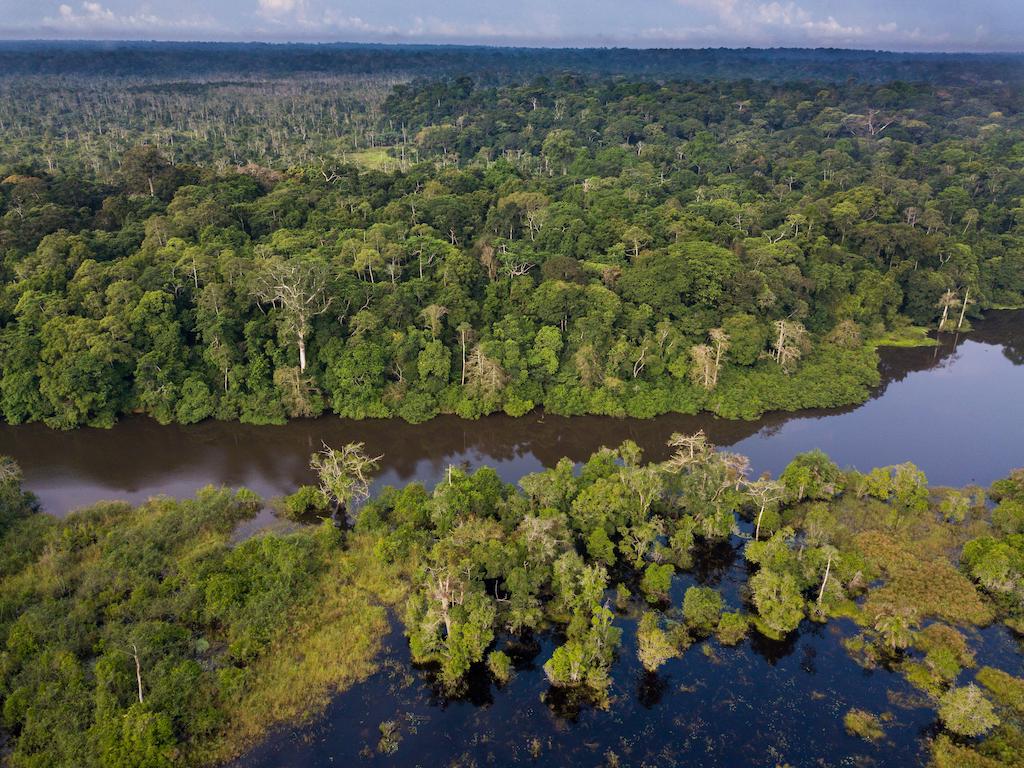
The importance of the Congo Basin’s rainforest in tackling climate change was frequently discussed at COP27, with various country pavilions holding events on how to ensure its preservation.
At a UK pavilion event attended by Carbon Brief, delegates heard from Lewis on how the Congo Basin currently remains one of the most intact, biodiverse and carbon-dense places on Earth.
Of particular importance for climate change is the basin’s vast tropical peatland complex. The largest of its kind in the world, the peatlands covers an area the size of England and contains 28% of the Earth’s entire tropical peat carbon stock, Lewis said.
However, the peatlands currently face unprecedented threats, including from oil-and-gas production licences issued by the DRC, as well as from the risk of drying caused by climate change.
A representative for the DRC environment ministry appearing alongside Lewis said the country needed more international support to balance the needs of protecting the environment and ensuring the development of its people.
“We are counting on other countries to help and support us,” he said at the event.
Road to nature COP15
COP27 took place just weeks before a major nature summit, COP15, is scheduled to begin in Montreal, Canada.
The much-delayed summit, which is formally hosted by China, will see countries aim to agree on a major new set of rules for tackling nature loss, known as the “post-2020 global biodiversity framework” (GBF).
A draft version of the GBF has a long list of wide-ranging targets, tackling everything from pollution to greenhouse gas emissions and subsidies harmful to nature, including fossil-fuel subsidies.
It comes amid a growing field of scientific research detailing how both the drivers and solutions for climate change and nature loss are deeply interconnected.
At COP27, some efforts were made to note these interlinkages – and the need for decisions in Sharm el-Sheikh to pave the way for progress in Montreal.
Today is Biodiversity Day at #COP27 – and the architects of the Paris Agreement have called for a similar deal for nature to be struck this year in Montreal
— Daisy Dunne (@daisydunnesci) November 16, 2022
Why do we need a global deal for saving nature and what does it mean for climate?
THREAD pic.twitter.com/k8b6X4bzIA
On the summit’s official Biodiversity Day, several of the architects of the Paris Agreement, including COP21 president Laurent Fabius, former UN climate chief Christiana Figueres and former French special representative and European Climate Foundation chief Laurence Tubiana, issued a call for a similar-scale pact to be achieved in Montreal in December.
The group issued a joint statement:
“There is no pathway to limiting global warming to 1.5C without action on protecting and restoring nature. Only by taking urgent action to halt and reverse the loss of nature this decade, while continuing to step up efforts to rapidly decarbonise our economies, can we hope to achieve the promise of the Paris Agreement.”
Separately, a group of 350 “civil society leaders”, including Indigenous voices and environmental charities, also issued a statement calling for world leaders to tackle catastrophic nature loss.
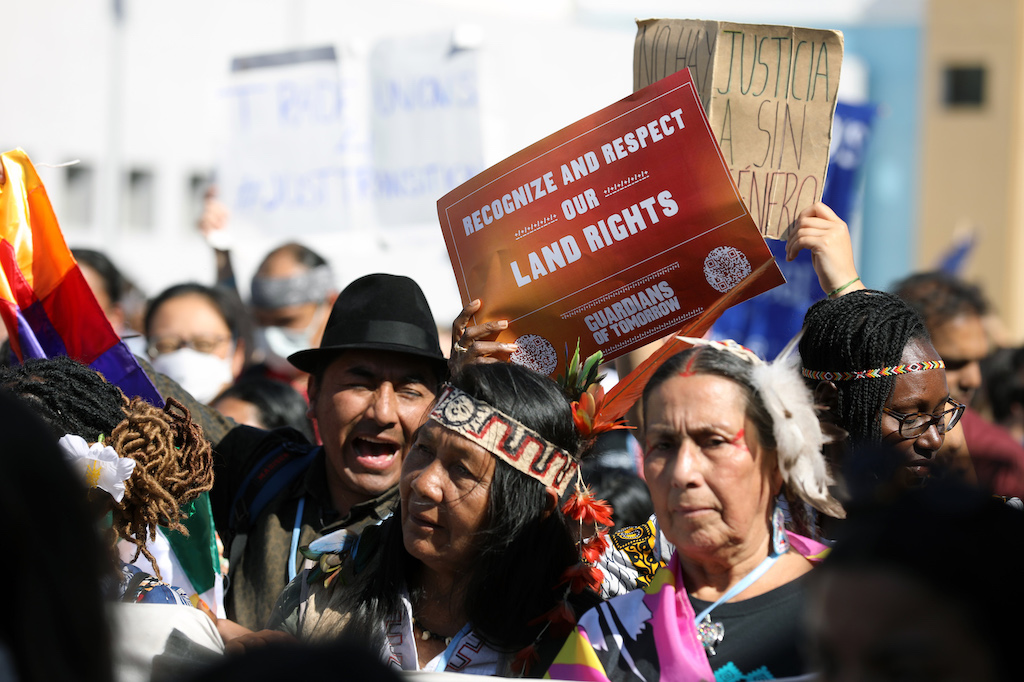
At a press conference attended by Carbon Brief, Helena Gualinga, an Indigenous youth leader from Sarayaku, Ecuador, urged world leaders to commit to taking steps towards tackling nature loss, as they have done for climate change. She told the venue:
“[COP15] is a once-in-a-decade opportunity – a decade we can’t afford to lose at this point – to address the very, very pressing issue of biodiversity loss and climate change. Leaders are abstaining from responsibilities by not attending this conference.”
(So far, the only major world leader set to attend the summit is Canada’s Justin Trudeau.)
Elsewhere at COP27, UK international environment minister Zac Goldsmith made numerous appearances at events across country pavilions, to stress the need for more joint action on climate change and biodiversity loss.
Speaking from #COP27 nature zone, @ZacGoldsmith says 112 countries have now pledged to protect 30% of land and oceans for nature by 2030.
— Daisy Dunne (@daisydunnesci) November 7, 2022
Others “on the cusp of joining” 30×30, including Philippines, Thailand, Vietnam, Malaysia pic.twitter.com/fZ321UyXJo
At a side-event held on 7 November, he gave an update on one of the flagship pledges of the GBF, a commitment to set aside 30% of the world’s land and oceans for nature by 2030.
Addressing the conference, he confirmed that 112 countries have now committed to the pledge. (This is up from 91 countries in March 2022.) He added that many other biodiverse nations were “on the cusp of joining”, including the Philippines, Thailand, Vietnam and Malaysia.
Despite calls for countries to take note of COP15, no mention of the summit appeared in the final agreement from COP27, the Sharm el-Sheikh Implementation Plan. (See: Food and nature in the cover decision.)
Carbon markets and Article 6
Negotiations at COP27 were being closely watched by voluntary carbon marketplaces, but also by forested countries, large emitters looking to offset their emissions, companies and civil society.
Views on carbon markets differ significantly. Many believe that carbon markets, including voluntary markets, can be an effective instrument for conservation. COP27, for instance, saw the launch of the African Carbon Markets Initiative, with an intention to “dramatically expand Africa’s participation in voluntary carbon markets”. The initiative involves seven African countries including Kenya, Malawi, Gabon, Nigeria and Togo and has the support of the UN “high-level champions”, Dr Mahmoud Mohieldin and Nigel Topping.
Others have decried all such markets as a “false solution” that puts ecosystems and Indigenous peoples at risk.
Concerned by Africa Carbon Market Initiative launch today at #COP27. African #carboncredits, bought by corporations in the global north, is a false solution that will create emissions reductions loopholes and won’t deliver the climate finance Africa needs https://t.co/li0g3HtAVU
— Mohamed Adow (@mohadow) November 8, 2022
Article 6 of the Paris Agreement, which governs carbon trading and other cooperative approaches to cutting emissions, is one of its most complex and most contested elements.
The “rulebook” for Article 6 was finalised at COP26 in Glasgow, but the architecture of these markets, definitions and procedures still needed to be decided at COP27, before trading could begin.
Late in the night before COP27 began, a UN “supervisory body” tasked with writing up rules on carbon removals suggested recommendations on what should count as a carbon removal and when this could generate carbon credits for sale.
Its recommendation was broad and non-specific, including land-based removals, ocean reservoirs, engineered solutions and products.
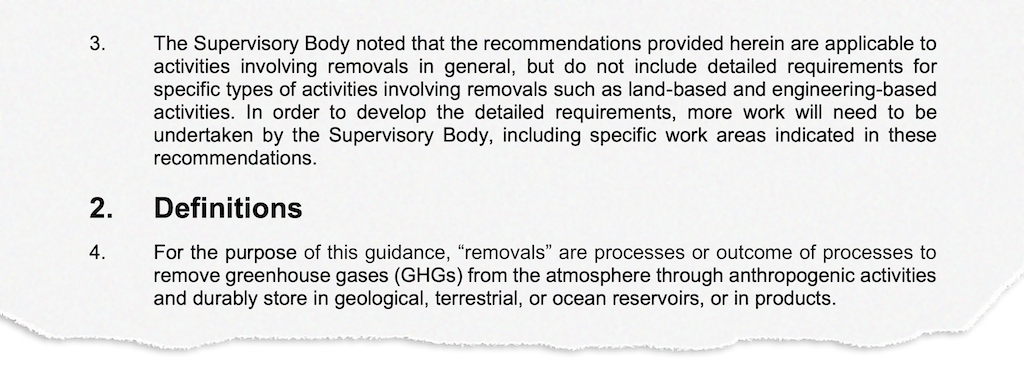
These recommendations were widely condemned by NGOs, who said they lacked safeguards on human rights and put Indigenous peoples, food systems and biodiversity at risk, including by putting solutions such as “engineering the oceans” on the cards.
2/7 decision adopted in middle of night makes clear that Supervisory Body is pressing forward opening the door for a wide range of “removals” incl. engineering of the oceans to “offset” emissions despite the existence of an international moratorium prohibiting this pic.twitter.com/vctA6G2yaH
— 🕊 Sébastien Duyck – at #COP27 🌍⚖️ (@duycks) November 6, 2022
Many parties also objected to the recommendations, with Third World Network reporting that the ABU grouping of Argentina, Brazil and Uruguay had called them “extremely problematic”.
Ultimately, COP27 sent this guidance back to the supervisory body for more work – an agreement supported by at least some of the body’s own members. It also said the revised recommendations should take into account “avoidance of other negative environmental and social impacts”.
Another controversial aspect that emerged in an early draft “non-paper” of the COP27 cover text was the use of REDD+ credits in Article 6.2. Observers told Carbon Brief this language – if it had been agreed – would have amounted to pre-judging the outcome of negotiations under Article 6.2, which have yet to conclude on the validity of REDD+ credits.

Trade in REDD+ credits between countries, to help meet climate targets, has been pushed by the Coalition for Rainforest Nations, which says that these credits have already gone through extensive verification and should automatically qualify for use under Article 6.
However, many observers note that verification under the two systems “does not amount to the same thing”. Erika Lennon at the Centre for International Environmental Law told Carbon Brief:
“Just because you qualify on REDD+ doesn’t automatically qualify you under Article 6’s rules and requirements. Being licensed to operate one type of vehicle doesn’t give you a licence to operate another one. If you have a licence to drive a car, you don’t get to fly a plane.”
The final COP27 text on Article 6.2 deferred a decision on the use of “emissions avoidance” credits – which might include some REDD+ projects – until COP29 in 2024. The final text on Article 6.4 also deferred a decision on avoidance credits, but only until COP28 in 2023.
-
COP27: Key outcomes for food, forests, land and nature at the UN climate talks in Egypt



